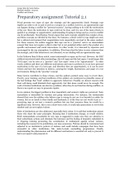Overig
Conflict and Crimes - Preparatory assignment about Rape and sexual violence as a war crime
- Instelling
- Vrije Universiteit Amsterdam (VU)
What is Wood’s argument against the distinction between “strategic” and “opportunistic” rape and what does she propose instead? ▪ Based on the accounts detailed in the Eriksson Baaz & Stern article, would you qualify rape by soldiers in the DRC as predominantly strategic, opportun...
[Meer zien]




